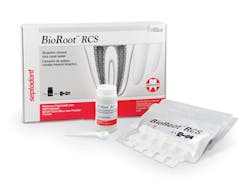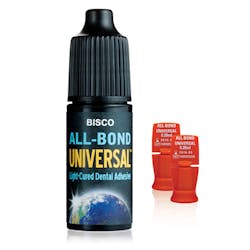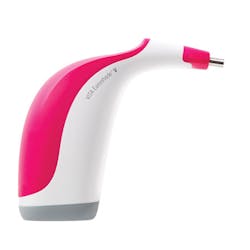Pearls for your Practice: Endo sealer, bonding agents, shade-taking device
BioRoot RCS by Septodont
Oh, how I hated endo in dental school! It's still not my favorite, actually . . . but it's getting better. We were taught using an archaic rotary-file system that would sometimes require 20 or 30 files for a single canal. We were taught obturation using lateral condensation. We spent hours on single-canal teeth. We felt so much joy when we found out that quicker methods existed. Since dental school, I have dabbled in many different methods of instrumentation and obturation. I have tried pretty much every file system on the market. For obturation, I have tried lateral condensation, warm vertical, warm gutta percha with a carrier, and now, a single cone. Single-cone obturation was really nice. It was quick and easy and gave a dense fill radiographically. The key to the single-cone technique is the sealer. BioRoot RCS root-canal sealer by Septodont is a great choice for the single-cone technique.
Most rotary-file systems have corresponding final gutta percha cones that match the size and shape of the final file. BioRoot RCS is a perfect sealer for this setup. Clean, shape, and irrigate the canal as you normally would. Try in and verify your master gutta percha cone. Dry the canal with paper points. Now it's time for BioRoot RCS. Mix it by dispensing five drops of mixing solution onto a mixing pad along with one spoonful of powder. Mix for one minute, and you should have a smooth paste. Using a measured paper point, apply BioRoot RCS sealer to the canal. Coat your gutta percha cone with a thin layer of BioRoot RCS and seat it in place. Clean up the excess sealer, remove the excess gutta percha, and you are done!
The minimum working time of BioRoot RCS is 10 minutes, and the max working time is four hours. The only disadvantage to this technique is that you should wait at least one week before preparing a post space. The sealer needs to fully set before this should be done. This might introduce an extra appointment if you were planning on doing endo, a post and core, and a crown in a single visit.
BioRoot RCS flows well and is easy to manipulate in the canal. It adheres well to the radicular dentin and the gutta percha, even in the presence of some moisture. Unlike some sealers that were popular a decade ago, BioRoot RCS is resin free and endodontic re-treatment is simple, should it be necessary. Another great quality of BioRoot RCS is its radiopacity. While it doesn't translate to clinical success, we all love to judge endodontic quality based on the radiograph. BioRoot RCS looks great on a radiograph.
BioRoot RCS has simplified my endo procedures and has made obturation much easier and faster. In addition, it looks even better than my previous methods on the radiograph. I have become a big fan of the single-cone technique with BioRoot RCS. Hard-hit double down the line for Septodont!
All-Bond Universal by Bisco Inc.
Stop etching dentin! Read that and let it sink in. We are damaging dentin with phosphoric acid-etching. Phosphoric acid is just too strong and consistently overetches dentin. When dentin is etched with phosphoric acid, we get side effects that we don't want. Primarily, we see the activation of matrix metalloproteinases (MMPs) that immediately begin to break down the bond. After a few years, the bond is gone completely. Acid-etched dentin also tends to be sensitive. By not etching dentin with phosphoric acid, you could eliminate sensitivity and bond degradation. Sounds pretty good, doesn't it?
That is what the new generation of universal bonding agents can do. Bisco's All-Bond Universal ranks toward the top of the category. Bisco is a company built on bonding. Several years ago, Bisco changed the indirect bonding world by developing one of the very first zirconia primers. But the company isn't a one-trick pony, and All-Bond Universal shows that. Like other universal bonding agents in its class, All-Bond Universal gives you etching options. You can total etch, selective etch, or self etch. In my practice, I only etch enamel with phosphoric acid. Enamel is robust and requires a strong acid to etch it. Enamel cannot be overetched. Dentin is much more fragile and is easily overetched. The gentle self-etching chemicals in All-Bond Universal can easily etch dentin without overetching. They aren't quite strong enough to etch enamel fully, though. That's why I etch enamel-and only enamel-with phosphoric acid. By using the selective-etch technique, I achieve a great bond to enamel and a really good bond to dentin.
All-Bond Universal is a great adhesive choice for direct composite restorations. It also exhibits excellent bond strength to pretty much all substrates, including e.max and zirconia. Its film thickness is very, very low, which is part of the reason that it works well with indirect restorations. It was designed to be fully compatible with light-cured, self-cured, and dual-cured composite and cement materials. With All-Bond Universal, you could potentially have everything you need bonding-wise in one bottle.
Bisco includes photographic instructions, which is a nice touch and something I think is important when selecting materials. Following directions, especially with bonding, is important. I am always impressed when a manufacturer takes the time to make well-designed instructions with good photos or illustrations.
Which bonding agent to use is one of the most important choices you make in your dental practice. You will use it multiple times a day. It needs to work well in your hands, and you need to have a very thorough understanding of its capabilities. In my opinion, it's time to closely examine the universal adhesives and consider a switch if you haven't already. Bisco's All-Bond Universal would be a great choice. It can be your bonding workhorse, covering all of your bonding needs. Solid triple into the corner for Bisco!
Easyshade V by Vita
In my junior-year esthetics class, Nasser Barghi, DDS, said, "Men do not see shades as well as women." He then encouraged the men in the class to defer to the women for shade-taking. It seemed silly to me to generalize that men couldn't see shades as well as women. Fast-forward to clinic: I realized that everything I saw looked like A2 and came to agree with Dr. Barghi. I don't see shades as intricately as some.
Several years ago, Vita debuted the Easyshade shade-taking device for shade-challenged dentists like me. The first unit was large, bulky, corded, and not simple to use. I had one and used it from time to time, but I never really loved it. Navigating the menus was difficult, and the device cluttered the countertop. Over the years, Vita has evolved the design. Last year, they debuted the Easyshade V. Cordless for the last few generations, the new design is fantastic. It is ergonomic and can be operated single-handedly. The charging station lies discreetly on the countertop. Since it's cordless, it doesn't even have to live in an operatory, which is a huge bonus for anal-retentive countertop eccentrics like me.
The Easyshade V is intuitive and easy to use. Powering it on prompts the user for a quick calibration. To calibrate the unit, you simply place it back on the charging station, and an audible beep will signal that the unit is ready. There is a touch screen on the bottom of the handle that gives the clinician the ability to choose different modes, such as base shade, average shade, or three shades per tooth. In the three-shade mode, the Easyshade V prompts the user to start at the gingival third, then move to the middle third, and then move to the occlusal or incisal third. There are also modes that would be more suited for ceramists working in laboratories.
Vita smartly improved its Classic Shade Guide in the late '90s by introducing the 3D-Master Shade Guide. The Easyshade V incorporates both of these so that you can use it on both direct and indirect restorations. The 3D-Master Shade Guide is a much more robust shade guide for indirect restorations-and it's the one you should absolutely be using. However great it is, none of our direct materials match that shade guide, and most come in Vita Classic shades. By having both, you can use the Easyshade V for anything from Class IV composites to ceramic veneers.
The Easyshade V is Bluetooth-connected. Since the unit saves 50 shade measurements with timestamps, you can pair the Easyshade V with your computer to transfer the data for record keeping.
I feel like the Vita Easyshade V makes my life easier when it comes to direct or indirect restorations on anterior teeth because I can quickly and accurately get a shade or multiple shades on the same tooth. My assistants like it because it helps give them confidence that they selected the correct shade. It has also enhanced my lab communication by allowing me to give my ceramist more complete and accurate shade information. I would highly recommend the Vita Easyshade V! Two-run home run for Vita!
About the Author
Joshua Austin, DDS, MAGD
Joshua Austin, DDS, MAGD, is a graduate and former faculty member of the University of Texas Health Science Center at San Antonio School of Dentistry. Author of Dental Economics’ Pearls for Your Practice column, Dr. Austin lectures nationally on products, dental technology, online reputation management, and social media. He maintains a full-time restorative dentistry private practice in San Antonio, Texas. You may contact Dr. Austin at [email protected].
Updated June 21, 2023



